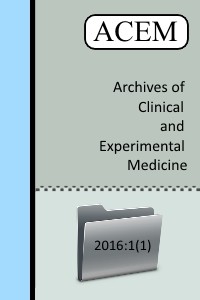Öz
Araç ve
yöntemler
Tanımlayıcı
bir çalışma tasarlandı. 2007 ile 2015 yılları arasındaki tüm apendektomiler
gözden geçirildi. Histopatolojik değerlendirme ile GA tanısı alan hastalar
çalışma grubunu oluşturdu. Geriye kalanlar kontrol grubu oluşturdu. Demografik
veriler, tam kan sayımı parametreleri (her biri için 22 parametre) kaydedildi.
Kategorik değişkenler frekanslar ve yüzdeler şeklinde ifade edildi. Temel
özellikler, t-testi ve Mann-Whitney U testi kullanılarak karşılaştırıldı.
Kategorik değişkenleri karşılaştırmak için Fisher'in kesin testi kullanıldı. P
değerinin %95 güven aralığında 0.05'den düşük olması halinde farklar
istatistiksel olarak anlamlı kabul edildi.
Bulgular
Çalışma
süresi boyunca 4570 hasta akut karın için akut apandisit teşhisi ile ameliyat
edildi. Çalışma grubunu sekiz hasta (%0,2) oluşturdu. Kontrol grubu için
örneklem büyüklüğü %50 farkı göstermek için, %95 güce sahip olacak şekilde, 2
taraflı %5 tip I hata oranı ile 385 olarak hesaplandı Hata payını azaltmak için
yapılan eklemeler (142) ile son sayı 527 olarak hesaplandı. Yaş ve cinsiyet
gibi demografik bulgular gruplar arasında fark göstermedi (sırasıyla p=0,499 ve
p=0,477). Çalışma grubunda EOS# ve EOS% kontrol grubuna göre daha yüksekti
(sırasıyla p<0,0001 ve p<0,0001). Lojistik regresyon analizi EOS%
etkisinin anlamlı olduğunu gösterdi (p<0,0001, odd’s oranı: 0,522,
Nagelkerke R2:0,191) .
Sonuçlar
Operasyonda
makroskopik görünümü ile GA'nın teşhisi cerrah için zorlayıcıdır. EOS # ve
EOS%'nin GA ile ilişkili olduğunu tespit ettik.
Anahtar Kelimeler
Kaynakça
- 1. A´ lvarez-Blanco M, Ferna´ndez-Mere´ LA, Martı´nez-Rodrı´guez E. Enfermedad de Crohn apendicular. Cir Esp. 2005;78:333–5.
- 2. Richards ML, Aberger FJ, Landercasper J. Granulomatous appendicitis: Crohn’s disease, atypical Crohn’s or not Crohn’s at all? J Am Coll Surg. 1997;185:13–7.
- 3. Bianchi A, Hidalgo LA, Fantova MJ, Sun˜ ol X. Granulomatous disease of the cecal appendix clinical significance. Med Clin (Barc). 2004;122:798.
- 4. Zissin R, Gayer G, Bernheim J, Kots E, Shapiro-Feinberg M, Hertz M. Granulomatous appendicitis presenting as right lower quadrant pain: CT findings. Abdom Imaging. 2003;28:280–3.
- 5. Higgins MJ, Walsh M, Kennedy SM, Hyland JM, McDermott E, O’Higgins NJ. Granulomatous appendicitis revisited: report a case. Dig Surg. 2001;18:245–8.
- 6. Kojima M, Morita Y, Shimizu K, et al. Immunohistological findings of suppurative granulomas of Yersinia enterocolitica appendicitis: a report of two cases. Pathol Res Pract 2007;203:115-9.
- 7. Bronner MP. Granulomatous appendicitis and the appendix in idiopathic inflammatory bowel disease. Semin Diagn Pathol 2004;21:98-107.
- 8. Nisani M, Cozacov C, Siegal A, et al. Granulomatous appendicitis. Harefuah 1984;106:123-5.
- 9. Guo G, Greenson JK. Histopathology of interval (delayed) appendectomy specimens: strong association with granulomatous and xanthogranulomatous appendicitis. Am J Surg Pathol 2003;27:1147-51.
- 10. AbdullGaffar B. Granulomatous diseases and granulomas of the appendix. Int J Surg Pathol 2010;18:14-20.
Association of granulomatous appendicitis and simple laboratory tests. Controlled observational study.
Öz
Aim: Granulomatous appendicitis (GA) is evaluated as different clinical situation from specific causes, and very rare. It is defined as the presence of granulomatous inflammation in the appendix. Its etiology can be infectious, or noninfectious. However its differentiation from tumor can be challenging with macroscopic appearance in the operation. In this study, we aimed to present a case series of GA cases, evaluate prediction and association of GA before surgery.
Material and methods
A descriptive study is designed. All appendectomies between 2007 and 2015 were reviewed. The patients who diagnosed with GA by histopathological evaluation constituted study group. The rest constituted the control group. Demographic data, complete blood count parameters (22 parameters for each) were recorded. Categorical variables were expressed as frequencies and percentages. Baseline characteristics were compared using the t-test and Mann-Whitney U test. Fisher’s exact test was used to compare categorical variables. The differences were considered statistically significant if the p value was less than 0.05 at a 95% confidence interval.
Results
During study period, 4570 patients were operated for acute abdomen with the presumptive diagnosis of acute appendicitis. Eight (0.2%) patients constituted study group. For control group sample size was calculated as 527 cases (95% power to show a 50% difference in the rate of the primary outcome, with a 2-sided type I error rate of 5%. Additional 142 to decrease errors). Demographic findings like age and gender didn’t show difference between the groups (p=0.499 and p=0.477, respectively). EOS# and EOS% were higher in study group than control group (p<0.0001 and p<0.0001, respectively). Logistic regression analysis showed that EOS% effect was significant with p of <0.0001, odds ratio of 0.522 and Nagelkerke R2 of 0.191.
Conclusion
Diagnosis of GA with macroscopic appearance in operation is a challenging for a surgeon. We found that EOS# and EOS% are associated with GA.
Anahtar Kelimeler
Kaynakça
- 1. A´ lvarez-Blanco M, Ferna´ndez-Mere´ LA, Martı´nez-Rodrı´guez E. Enfermedad de Crohn apendicular. Cir Esp. 2005;78:333–5.
- 2. Richards ML, Aberger FJ, Landercasper J. Granulomatous appendicitis: Crohn’s disease, atypical Crohn’s or not Crohn’s at all? J Am Coll Surg. 1997;185:13–7.
- 3. Bianchi A, Hidalgo LA, Fantova MJ, Sun˜ ol X. Granulomatous disease of the cecal appendix clinical significance. Med Clin (Barc). 2004;122:798.
- 4. Zissin R, Gayer G, Bernheim J, Kots E, Shapiro-Feinberg M, Hertz M. Granulomatous appendicitis presenting as right lower quadrant pain: CT findings. Abdom Imaging. 2003;28:280–3.
- 5. Higgins MJ, Walsh M, Kennedy SM, Hyland JM, McDermott E, O’Higgins NJ. Granulomatous appendicitis revisited: report a case. Dig Surg. 2001;18:245–8.
- 6. Kojima M, Morita Y, Shimizu K, et al. Immunohistological findings of suppurative granulomas of Yersinia enterocolitica appendicitis: a report of two cases. Pathol Res Pract 2007;203:115-9.
- 7. Bronner MP. Granulomatous appendicitis and the appendix in idiopathic inflammatory bowel disease. Semin Diagn Pathol 2004;21:98-107.
- 8. Nisani M, Cozacov C, Siegal A, et al. Granulomatous appendicitis. Harefuah 1984;106:123-5.
- 9. Guo G, Greenson JK. Histopathology of interval (delayed) appendectomy specimens: strong association with granulomatous and xanthogranulomatous appendicitis. Am J Surg Pathol 2003;27:1147-51.
- 10. AbdullGaffar B. Granulomatous diseases and granulomas of the appendix. Int J Surg Pathol 2010;18:14-20.
Ayrıntılar
| Konular | Cerrahi |
|---|---|
| Bölüm | Orjinal Makale |
| Yazarlar | |
| Yayımlanma Tarihi | 27 Aralık 2016 |
| Yayımlandığı Sayı | Yıl 2016 Cilt: 1 Sayı: 1 |

